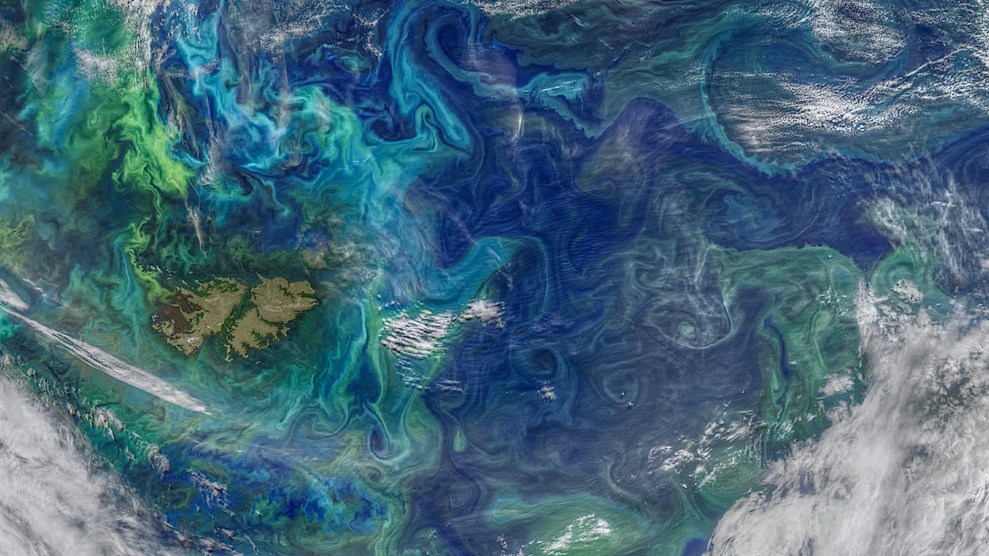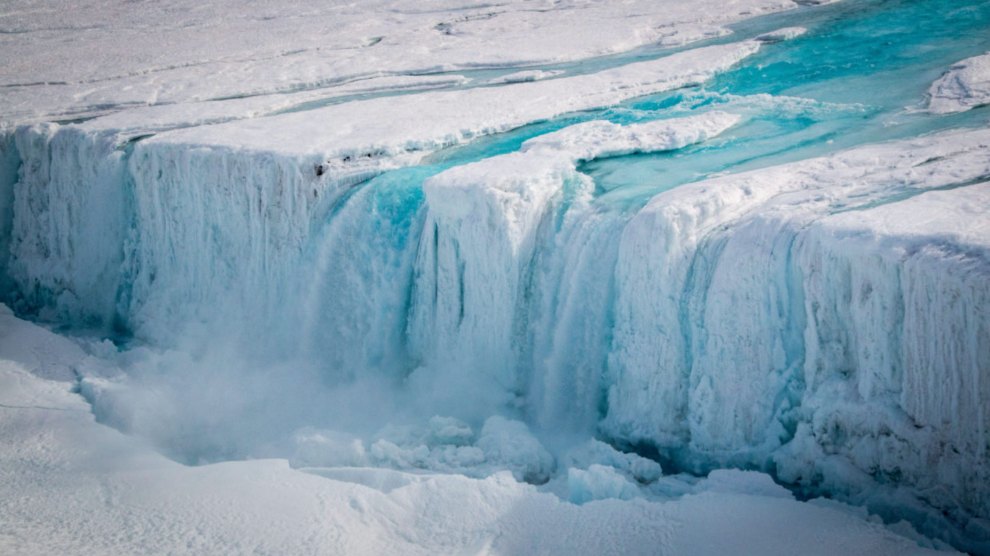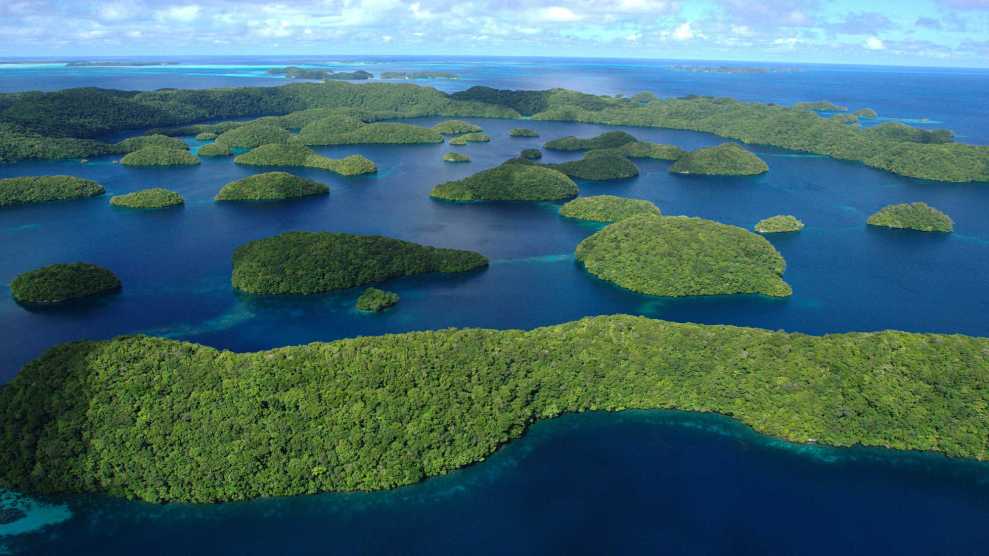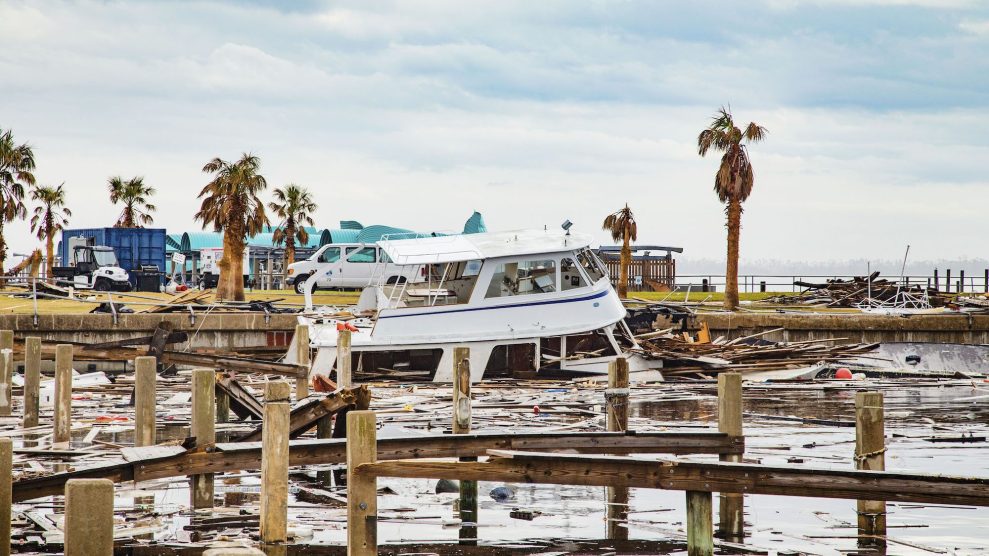
Cover Images/Zuma Press
This story was originally published by Wired and is reproduced here as part of the Climate Desk collaboration.
So much on this planet depends on a simple matter of density. In the Atlantic Ocean, a conveyor belt of warm water heads north from the tropics, reaching the Arctic and chilling. That makes it denser, so it sinks and heads back south, finishing the loop. This system of currents, known as the Atlantic Meridional Overturning Circulation, or AMOC, moves 15 million cubic meters of water per second.
In recent years, researchers have suggested that because of climate change, the AMOC current system could be slowing down and may eventually collapse. A new paper published in the journal Nature Communications warns that the collapse of the AMOC isn’t just possible, but imminent. By this team’s calculations, the circulation could shut down as early as 2025, and no later than 2095.
That’s a tipping point that would come much sooner than anyone thought. “We got scared by our own results,” says Susanne Ditlevsen, a statistician at the University of Copenhagen and coauthor of the new paper. “We checked and checked and checked and checked, and I do believe that they’re right. Of course, we might be wrong, and I hope we are.” But there’s vigorous debate in the scientific community over just how quickly the AMOC might decline, and how best to even figure that out.
It’s abundantly clear to researchers that the Arctic is warming up to four and a half times faster than the rest of the planet. Arctic ice is melting at a pace of about 150 billion metric tons per year, says Marlos Goes, an oceanographer from the University of Miami and NOAA’s Atlantic Oceanographic and Meteorological Laboratory who was not involved with the new paper. Greenland’s ice sheet is also rapidly declining, injecting more freshwater into the sea. That deluge of freshwater is less dense than saltwater, meaning less water sinks and less power goes into the AMOC conveyor belt.
The consequences would be brutal and global. Without these warm waters, weather in Europe would get significantly colder—more like that of similar latitudes in Canada and the northern United States. “In model simulations, the collapse of the AMOC cools the North Atlantic and warms the South Atlantic, which may result in drastic precipitation changes throughout the world,” Goes says. “There would be changes in storm patterns over the continental areas, affecting the monsoon systems. Therefore, a future AMOC shutdown could bring massive migration, impacting ecological and agricultural production, and fish population displacement.”
Ditlevsen did her team’s calculation by using measurements of Atlantic sea surface temperatures as a proxy for the AMOC. These readings go all the way back to the 1870s, thanks to measurements taken by ship crews. This meant researchers could compare temperatures before and after the start of the wide-scale burning of fossil fuels and the ensuing changes to the climate.
Because the AMOC system involves warm water heading north from the tropics, if the circulation is slowing down, you’d expect to find cooler temperatures in the North Atlantic over time. And indeed, that’s what Ditlevsen’s group found, once they compensated for the overall warming of the world’s oceans due to climate change. “When it is established that the sea surface temperature record is the fingerprint of the AMOC, we can calculate the early warning signals of the forthcoming collapse and extrapolate to the tipping point,” says University of Copenhagen climate scientist Peter Ditlevsen, coauthor of the new paper. (The Ditlevsens are siblings.)
The result echoes previous studies finding early warning signals in the circulation, says Stefan Rahmstorf, who studies the AMOC current system at the Potsdam Institute for Climate Impact Research. “As always in science, a single study provides limited evidence, but when multiple approaches lead to similar conclusions, this must be taken very seriously, especially when we’re talking about a risk that we really want to rule out with 99.9 percent certainty,” says Rahmstorf. “The scientific evidence now is that we can’t even rule out crossing a tipping point already in the next decade or two.”
Still, scientists don’t agree about whether sea surface temperature is a good indicator of the health of this massively consequential circulation. “Fundamentally, I am deeply skeptical that SST is actually a proxy of AMOC,” says climate scientist Hali Kilbourne, who studies the current system at the University of Maryland Center for Environmental Science. “But there’s certainly a school of thought of people who think it’s the best thing going—and it may be the best thing going right now. I don’t think we have a good alternative, which is why people are using it.”
“I really question whether [SST] is an adequate proxy for AMOC itself,” agrees Kevin Trenberth, a climate scientist at the National Center for Atmospheric Research. “But the trouble is there aren’t really adequate measurements.”
The core of the issue is that sea surface temperatures are just one component of the AMOC system; other factors also help determine Atlantic temperatures. Warm waters flowing north have an effect, but so does the atmosphere touching the water. “There’s a lot of what we call air-sea interactions—the heat exchange between the atmosphere and the ocean,” Kilbourne says. “And that’s not at all related to ocean circulation.”
“This SST fingerprint, although sensitive to the AMOC, is not solely driven by it, so these changes may be overestimated,” agrees Goes, the oceanographer from the University of Miami and NOAA. “Current climate models do not give a strong probability of the collapse of the AMOC this century.”
The beauty of the SST dataset is that it stretches back 150 years, so scientists can see longer-term trends in temperatures. However, those early shipboard measurements were made by people hauling buckets of water aboard and sticking a thermometer in—not exactly the precision that modern science demands. “It is not ideal, but it’s the best we can do,” says Peter Ditlevsen, “since we need measurements to go back to the pre-industrial era to assess the natural state of the AMOC, before it began slowing down toward the collapse.”
Satellite measurements of SST began in the late 1970s, providing much better coverage across oceans. And it wasn’t until 20 years ago that scientists deployed a dedicated AMOC sensor array, known as RAPID, which also measures current velocities and salinity—another factor that influences the density of water. By comparing this modern data to the historical SST data, Peter Ditlevsen says, they can compensate for the influence of the atmosphere on the sea surface, isolating the signal of the AMOC system.
When the RAPID array went online, the assumption was that it’d take 40 years to get an idea of whether the current system was in decline. “It’s just hard to tease apart, because we really don’t know what the intrinsic timescales of AMOC are,” says Nicholas Foukal, an assistant scientist at Woods Hole Oceanographic Institution, who wasn’t involved in the new paper. “We haven’t had an AMOC collapse in the past 20 years, so it’s like trying to predict a hurricane—having never seen a hurricane.”
Since RAPID started operating, scientists have seen a good amount of variability. “We’ve been directly measuring AMOC since 2004, and we don’t have any evidence of long-term decline,” says Foukal. “The first six years, there was a very strong decline. And people jumped on that, saying that it’s declining, and we have observational evidence of it. But since then, it has recovered.”
Scientists also use models to simulate how the current system might change as the climate does. Compared to the studies indicating a slowdown and eventual collapse of the circulation, models indicate more stability, says Oluwayemi Garuba, a climate scientist who studies ocean-atmosphere interactions at the Pacific Northwest National Laboratory. “Observations are showing more statistically significant early-warning signals of a collapse of the AMOC, whereas most models are not showing that,” says Garuba. “So, it could be that the overturning circulation in models is just more stable than in observation, as earlier studies have suggested.”
Going forward, Greenland will be a major wildcard. Last week, scientists reported how they used ice cores from an abandoned military base to determine that around 400,000 years ago, northwest Greenland was ice-free. Back then, temperatures were about the same as they are today, yet atmospheric carbon dioxide concentrations were far lower. That raises the alarm that the decline of Greenland’s ice sheet could accelerate. If it does, the melt would load the north Atlantic with astonishing amounts of freshwater, fast-tracking the decline of the AMOC and adding many feet to sea levels.
It’s complexity and uncertainty all the way down. “The fact that, with continued warming, AMOC will slow down is a very robust result. The uncertainty—and where science still needs to figure things out—is when,” Kilbourne. “But I kind of think that by the time we figure out when, it’ll already have happened.”













